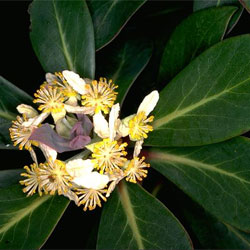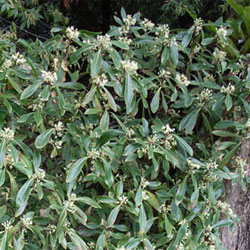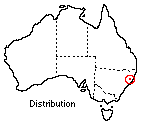Tasmannia purpurascens
 |
 |
Broad-leaved Pepperbush
Tasmannia purpurascens (Vickery) A.C.Sm.
Tasmannia purpurascens is a useful foliage plant 1-3 m high and 1.5 m wide. It was first described in 1937 by J. W. Vickery as Drimys purpurascens and is often listed under this name in older literature. Tasmannia is of particular interest to botanists as it is a member of the primitive family Winteraceae. Members of the genus have been given the common name of Pepper Bushes because of the hot-flavoured fruit, seeds and sometimes foliage, which have been used as a condiment.
 The
distribution of T. purpurascens is limited to the Gloucester Tops and
Barrington Tops in the Central Tablelands of New South Wales, where it grows
abundantly at 1300 m in moist Eucalyptus forest. Frosts are common in winter
and snow is not unknown. Fogs and misty rain can occur throughout the year.
The
distribution of T. purpurascens is limited to the Gloucester Tops and
Barrington Tops in the Central Tablelands of New South Wales, where it grows
abundantly at 1300 m in moist Eucalyptus forest. Frosts are common in winter
and snow is not unknown. Fogs and misty rain can occur throughout the year.
Although the plant seems adaptable to a range of situations it favours the protection of trees and can grow in deep shade. In cultivation T. purpurascens grows best on freely draining soil with good moisture retention although it can grow in quite heavy soil. Reasonably high moisture levels are required both in summer and winter for healthy growth. As they grow slowly they respond to a light application of general fertiliser in spring and early autumn.
The most attractive feature of the plant is its large 100-200 mm long leaves. They are oblanceolate; pointed at the apex, widening to 20-70 mm about one-third the way along the blade and tapering from there back to the flattened leaf base. The leaves are dark glossy green on the upper surface and slightly paler underneath, with a purple raised midrib. The appeal of the foliage is enhanced by the reddish-purple colouring of the tip growth and the reddish stems.
The creamy white flowers are 25 mm in diameter and are borne in pseudo-terminal or axillary umbels. Individual flowers are either male or female but both appear on the same plant. The fruit, consisting of groups of 3-6 succulent berries, deep blackish purple in colour and 10-15 mm long, remain on the plant for some time, adding to the overall attractiveness of this species.
Tasmannia purpurascens does not attract many pests and diseases, although in glasshouse and indoor situations it may be attacked by mealy bug, which may distort the foliage. Thrip has also been seen to damage leaves and cause defoliation in the open garden. Plants are readily propagated from cuttings in early autumn. Propagation from seed has been difficult. Tip pruning of young plants, especially those in deep shade, will help keep a rounded bushy appearance.
The slow growth, attractive foliage and fruit and a high tolerance to low light make T. purpurascens an ideal indoor plant. It could also be used to effect as an outdoor pot plant in shade or in a fernery.
Text by Brian Casey, ANBG (1983)
Name meaning: Tasmannia purpurascensTasmannia - After AW Jansen Tasman, navigator, for whom the state of Tasmania was named; purpurascens - becoming purple, referring to the reddish-purple midrib of the leaf. |
![An Australian Government Initiative [logo]](/images/austgovt_brown_90px.gif)

